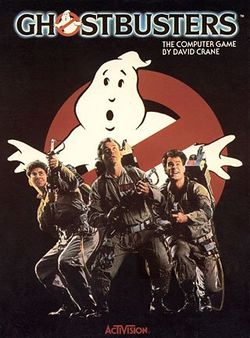This is the first game in the Ghostbusters series. For other games in the series see the Ghostbusters category.

| Ghostbusters | |
|---|---|
| Developer(s) | Activision |
| Publisher(s) | Activision |
| Year released | 1984 |
| System(s) | Amstrad CPC, Apple II, Atari 2600, Atari 8-bit, Commodore 64/128, DOS, MSX, NES, Sega Master System, Sinclair ZX Spectrum |
| Followed by | Ghostbusters (1986) |
| Series | Ghostbusters |
| Designer(s) | David Crane |
|---|---|
| Genre(s) | Action |
| Modes | Single player |
- This guide is for the 1984 Activision game. For the 1986 West End game, the 1990 Sega game, the 2013 Beeline Interactive game and the 2016 FireForge-developed Activision game, see Ghostbusters (1986), Ghostbusters (1990), Ghostbusters (2013) and Ghostbusters (2016).
Ghostbusters is a licensed game by Activision based on the movie of the same name. It was designed by David Crane, produced by Brad Fregger, and released for several home computer platforms in 1984, and later for video game console systems, including the Atari 2600, Sega Master System and NES. All three of these later version contain differences from the original home computer versions. The Atari 2600 version is generally considered the worst looking version (although quite good for a 2600 game) and the Sega Master System has the worst sounding version (the main theme that plays constantly throughout the game is off-key), but the award for least playable falls squarely on the NES conversion. The programmer for the initial version of the game was Adam Bellin.
The player sets up a ghost busting franchise in a city with a rising Psychokinetic (PK) Energy level and has the ability to purchase equipment such as traps, or to upgrade their vehicle. The player then negotiates a grid representing the city. They need to stop the "roamers" from reaching the temple of Zuul (which causes the PK Energy level to jump). When the player moves to a city block that is flashing red, the game mode switches to an overhead view of the player's vehicle driving to the location. The player must move left and right to vacuum up the stray ghosts and avoid cars. The player then moves to a screen in which a Slimer ghost must be guided with two proton streams over a ghost trap.
If the ghost is successfully captured, the player's income increases. The aim is to have $10,000 by the time the city's PK level reaches 9999, wherein the Stay-Puft Marshmallow Man will appear and wreak havoc on the city, thereby ending the game. In some versions (e.g. the Commodore 64 version), after the first successful game, the player is given an account number, which stores the amount of money the player had at the end of the game. This allowed for purchasing more expensive items for use (faster cars, more traps etc.). In order to win at these games the player was required to have earned more money than their initial account balance. This is one of the earliest uses of passwords being used as a 'save game' feature on home computers.
Some ports of the game (especially the Sinclair ZX Spectrum and the Commodore 64 version) are significant for their attempt at playing back rudimentary speech samples ("Ghostbusters!", "He slimed me!"), a novelty at the time. The Commodore 64 version was noted for having the best synthesized speech and music, with a very good representation of the Ghostbusters theme song used as background music.
Story[edit]
After being kicked out of their university, parapsychology professors Spengler, Stantz and Venkman decide to go into business for themselves by trapping and removing ghosts from haunted houses. After some initial skepticism, business is soon booming as The Ghost Busters rid New York of its undead. When a downtown skyscraper becomes the focal point of spirit activity linked to the ancient god Gozer, however, the problem may be more than the team can handle.